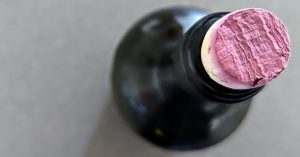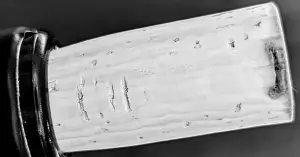
Taking the first sip of a new-to-me wine is always an experience. I never know what to expect. But how do you go about tasting the wine, exactly?
After you take your first sip, you should hold the wine in your mouth for several seconds. Let the wine move across your tongue and feel the wine’s texture. This will warm up the wine and release more of the flavor molecules, making the wine more flavorful. You should also hold wine in your mouth if you want to do a quality assessment of your wine.
Most of our immediate perceptions about a particular glass of wine come from its smell, but wine’s a fully immersive sensory experience and your mouth is here to help you unlock the many secrets in your glass!
Why You Should Hold Wine in Your Mouth

You want to take a sip of your wine and let it sit on your tongue because your body temperature will warm up the wine.
This temperature change loosens the chemical bonds of the aroma compounds.
If you swish the wine around in your mouth or slurp your wine, these aroma compounds will travel to your retronasal passage and you’ll get a powerful hit of aromas.
Do you sense fruit, oak, vanilla, yeast, or even tobacco?
Oftentimes, when you can’t quite smell a particular aroma in the wine itself, taking a sip and holding the wine in your mouth for several seconds can help you confirm your first impressions of a wine.
Other times, you’ll smell a wine and miss an aroma completely. Holding the wine in your mouth may warm the wine up just enough to unlock those molecules and help you pick out that missing smell.
Aside: I always miss black pepper when I smell a wine, but pick it out when I hold the wine in my mouth for about 20 seconds.
What Else Should You Do While Holding the Wine in Your Mouth?
Another good reason you want to let the wine sit in your mouth for several seconds is to taste for the wine’s structure. Ask yourself these questions:
How Intense Are the Wine’s Flavors?
Higher quality wines explode in your mouth, with flavors moving across your lips and over your tongue in waves. This is the wine’s intensity. Less intense wines will still have flavors to them, but nothing like a flavor bomb.
How Sharp or Sour Is the Wine?
This is the wine’s acid. Does your mouth start to water? If so, how much? Rieslings will have stinging acidity, for example, while Sherry wines have low levels of acid.
How Sweet Is the Wine?
Wines that have a slippery quality on your lips and tongue likely have a little sweetness to them. Entry-level everyday red wines often have sugar added to them to appeal to many drinkers. These are good wines to taste subtle sweetness. Wines like White Zinfandel are always off-dry, too. Can you feel and taste if there’s sugar?
How Drying Is the Wine?
Move the wine around with your tongue. Does it grip your mouth like sandpaper? These are the wine’s tannins and they are a tactile sensation, not a flavor. Wines like Cabernet Sauvignon will have strong tannins while Gamay expresses softer tannins.
Tip: Check out this helpful 30-second wine tasting tip on how to taste tannins.
Does Your Mouth Start to Burn?
That burning sensation is the alcohol in your wine. Higher alcohol wines, like Port or a Lodi Zinfandel, will cause a noticeable burn on your cheeks and tongue (especially under your tongue). Lower alcohol wines, like Moscato d’Asti, may not even leave a tiny prickle.
Is the Wine Very Bitter?
Bitterness is another flavor, like sweetness, that you may discover in your wine if you hold it in your mouth. Bitterness comes from alcohol that’s not well integrated into your wine. Well-made wines won’t have noticeable bitterness. Obvious bitterness in your wine means it’s out of balance.
Helpful Tip: Go check out this quick tip to figure out if your wine is bitter or astringent.
How Heavy Is the Wine?
A wine sits on your tongue and it has a weight to it, or the wine’s body. Some wines have more weight, and more body, than others. Think of the difference between skim milk and heavy whipping cream. The same goes for wine. Roll the wine over your tongue and think about its weight.
Do You Have to Hold the Wine in Your Mouth Each Time You Take a Sip?

Each time a wine pro does a serious quality assessment for a wine, they’ll hold the wine in their mouths for several seconds after each sip.
Why?
They’re thinking about all of the questions above and trying to decide just how good a wine is.
Sometimes a wine’s intensity is obvious, but sometimes they need to think about it a little more. Sometimes they can taste alcohol and tannin immediately, but need to go back and taste for sugar and acid.
Each sip unlocks different qualities and a different story for the wine they’re tasting.
These questions are fundamental for blind tastings. Wines made with grapes from different growing regions or with distinctive winemaking traditions have unique profiles. Answering each of the questions gives clues about a wine if it’s a blind tasting. A professional taster can piece together those clues and make an educated guess about what wine they’re tasting.
Examples:
- A light, low alcohol, fruity, slightly spritzy wine is likely a Moscato d’Asti.
- A high alcohol, richly oaked, high tannin wine with jammy cassis is likely a Napa Valley Cabernet Sauvignon.
The more flavors and structural nuances you can pull from a wine, the more you’ll be able to build your own mental library of wines you like and dislike and – just as important – the qualities in a wine you like and dislike.
As a wine lover, you don’t need to pause after every sip of wine!
Questions to Ask Yourself While Holding Wine in Your Mouth
But if you’re curious about sifting through the different qualities of a wine, then you should hold the wine in your mouth for the first few sips and think about these questions:
- What do I taste?
- How intense are the flavors?
- How sharp is the wine?
- How drying is the wine?
- Does my mouth burn?
- How bitter is my wine?
- How heavy is the wine?
The last step after you’ve swallowed is to ask yourself: Do I like this wine? Every wine drinker has different wine preferences, and there’s no right answer to this question. You’ll come across wines that will rock your world and others that will go straight down the kitchen sink. Wine happens!
Ready to Discover More?
As a new wine drinker, I found that hosting wine tastings at home was probably the best way to learn more about wine, but it took me a while to figure out how to organize home tastings effectively.
So, I wrote this quick how-to post to host a home wine tasting for beginners, along with recommended tasting flights to help you discover different wines.



